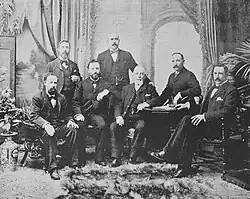Liberal–Labour (New Zealand)
Liberal–Labour (often referred to as "Lib-Lab") was a political association in New Zealand in the last decade of the nineteenth and first half of the twentieth centuries. It represented candidates who stood for the New Zealand Liberal Party while also receiving endorsement and support from the labour (trade union) movement.

History
Initially, Liberal–Labour candidates were usually members of the Liberal Party who received Labour movement endorsement and/or advocated on behalf of labourers and trade unions in parliament. This was mainly a result of the early unionists being mostly anti-political.[1] In 1890 there was a "Lib-Lab" alliance where Liberals and Labour sympathizers co-operated with each other. The two agreed on candidates who ran on combined tickets in several electorates. Equally, in others where only one was running against a government member, supporters of both backed each other's candidates.[2] Most Liberal-Labour support initially came from the South Island; prior to 1905, only one MP considered to be Liberal-Labour (John Hutcheson) came from a North Island seat.
When the Liberal Party won power in 1890, five members of John Ballance's caucus claimed to be "Labour" MPs. They claimed to be from a Labour "party", though it was mostly regarded that they were merely the Labour "faction" of the Liberals.[3] In the 1893 election they were joined by two more Liberals identifying as representing Labour interests.[3] However, in 1896 three of the Labour members were defeated and the remaining Labour aligned Liberals merged more definitely with the other Liberals.[4] The Liberals attempted to strengthen their support base with unionists by creating the Liberal-Labour Federation in 1899 hoping to attract formal trade union support.[5] Many electoral alliances were formed between the Liberals and Labour particularly during second ballots in the 1908 and 1911 elections.[6]
During the period 1904–13 there was increasing debate by unionists on the issue to separate themselves from the Liberals, which ultimately led to the creation of the present-day Labour Party in 1916.[7]
Notable Liberal-Labour MPs
| Name | Electorate | From | To | Notes |
|---|---|---|---|---|
| William Tanner | Heathcote Avon |
1890 1893 |
1893 1908 |
Considered to be "the first Labour candidate" elected to Parliament.[8] |
| David Pinkerton | City of Dunedin | 1890 | 1896 | |
| William Earnshaw | Peninsula City of Dunedin |
1890 1893 |
1893 1896 |
|
| Lindsay Buick | Wairau | 1890 | 1896 | |
| James Whyte Kelly | Invercargill | 1890 | 1899 | |
| Ebenezer Sandford | City of Christchurch | 1891 | 1893 | First elected in by-election |
| John A. Millar | Chalmers City of Dunedin Dunedin Central Dunedin West |
1893 1896 1905 1911 |
1896 1905 1911 1914 |
Liberal only from 1905 onwards |
| John Hutcheson | City of Wellington | 1896 | 1902 | |
| James Arnold | City of Dunedin Dunedin South Dunedin Central |
1899 1905 1908 |
1905 1908 1911 |
|
| Alfred Barclay | City of Dunedin Dunedin North |
1899 1905 |
1902 1908 |
|
| James Thomas Hogan | Wanganui | 1905 | 1911 | Independent MP for Rangitikei, 1928–31 |
| Robert Beatson Ross | Pahiatua | 1905 | 1911 | |
| Tommy Taylor | Christchurch North | 1908 | 1911 | New Liberal MP 1905, died in office |
| Sydney George Smith | Taranaki | 1919 | 1922 | Joined the Liberal Party in 1922 |
Notes
- Brown 1962, pp. 2.
- Hamer1988, pp. 32–3.
- Brown 1962, pp. 2–3.
- Brown 1962, pp. 3.
- Brown 1962, pp. 4.
- Gustafson 1980, pp. 80.
- Brown 1962, pp. 5.
- Cyclopedia Company Limited (1903). "Mr. William Wilcox Tanner". The Cyclopedia of New Zealand : Canterbury Provincial District. Christchurch: The Cyclopedia of New Zealand. p. 91. Retrieved 8 September 2010.
References
- Brown, Bruce (1962). The Rise of New Zealand Labour: A history of the New Zealand Labour Party. Wellington: Price Milburn.
- Hamer, David A. (1988). The New Zealand Liberals: The Years of Power, 1891–1912. Auckland: Auckland University Press. ISBN 1 86940 014 3.
- Gustafson, Barry (1980). Labour's path to political independence: The Origins and Establishment of the New Zealand Labour Party, 1900–19. Auckland, New Zealand: Auckland University Press. ISBN 0-19-647986-X.